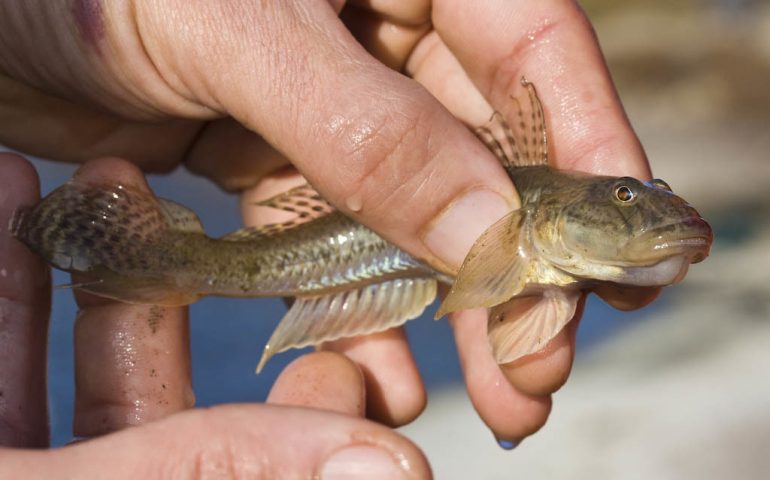Gobies: Family Gobiidae
Species: Acanthogobius flavimanus (Temminck & Schlegel, 1845).
Alternate Names: Japanese river goby (Former USSR), Mahaze (Japan), Spotted goby (Viet Nam), Yaponskii rechnoi bychok (Former USSR). Called gobio extranjero in Mexico.
Identification: Typical goby shape. Color varies, generally brown but can be light gray with black speckling and bars; a zigzag pattern of bars on the upper part of the caudal fin.
Size: The largest local goby reaching 9.8 inches in length; reaches 12 inches in Japan. Most caught from piers are under 8 inches.
Range: Native to Asia—Russian coast of Sea of Japan, Japan, China and Korea. They were first recorded in California in 1963 when a specimen was found near Venice Island in the San Joaquin River. Soon after, a second specimen was taken from the Stockton Deepwater Channel. Today they are found in every California bay from San Diego Bay to Tomales Bay and extend south to Ensenada. It is not known how they arrived from Asia. They may have arrived as ships’ ballast, they may have arrived as eggs on fouling organisms (i.e., oysters). Although first reported from Suisun Marsh in 1967, by the early ‘80s they were reported as the third most common fish taken in trawl catches. Studies done at Mowry Slough in South San Francisco Bay at the Don Edwards National Wildlife Refuge show that 54% of the food of local Bay seals was yellowfin gobies (the site is the primary pupping site for harbor seals in the South Bay).
Habitat: Shallow-water mudflat areas in bays and lagoons as well as coastal and inland waters. Recorded to a depth of 45 feet.
Piers: Occasionally caught from piers, primarily those in San Francisco Bay. I have caught them at a pier along the San Francisco waterfront (Agua Vista Pier), East Bay piers (Fruitvale Bridge Pier and San Antonio Pier), as well as at the Rio Vista Pier in the Sacramento-San Joaquin Delta. Since they, like longjaw gobies (mudsuckers) are considered excellent bait for striped bass, the question becomes how to catch them. All that I have caught were taken on pile worms while using small hooks and fishing for perch. However, we received a report on PFIC in 2008 from minnowmagnet who said “I was fishing for flounder yesterday and caught a couple of mudsuckers; I caught a couple more this morning on a one-inch crappie jig. Today I cast out a rod for flounders with worms and then fished an ultralight with a tiny red and white crappie jig to catch gobies for bait. I fished a lure for gobies for a couple hours by working them slowly along the bottom in the open and under my dock. I ended up catching 36 yellowfin gobies from 4” to 8” and a 3.5” chameleon goby.” So, if you’re fishing near a muddy bottom that might contain the gobies you might want to try a crappie jig or similar tiny lure to catch some live bait.
Shoreline: Occasionally caught by anglers fishing shoreline areas in San Francisco Bay.
Boats: An inshore species rarely take from boats.
Bait and Tackle: Generally caught while fishing on the bottom for other species.
Food Value: Considered a delicacy in Japan where they are usually sold alive.
Comments: Yellowfins apparently make seasonal movements in the Bay Area. They spawn in the winter and early spring in San Pablo Bay and then the young of the year move into the Delta before returning back down the river to the Bay in the fall. Apparently the majority then die. In some areas it is feared that they may have replaced Pacific staghorn sculpins and the endangered tidewater goby—Eucyclogobius newberryi.
